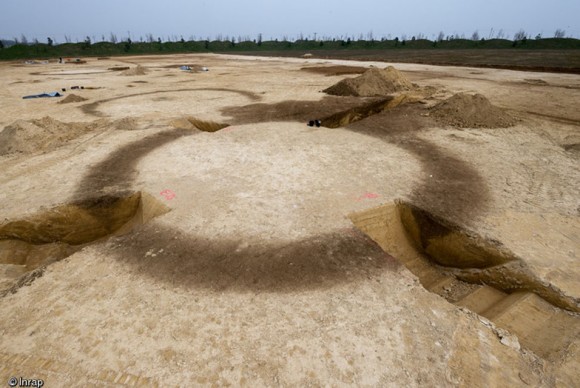French archaeologists uncover a Gallic necropolis from the 4th and 3rd centuries BC
May 4, 2013 by All Art News
Filed under Antiques & Archaeology
PARIS.- An Inrap team has recently uncovered a Gallic necropolis from the 4th and 3rd centuries BC on the site of the Parc Logistique de l’Aube, at Buchères. Since 2004, the 260 hectares of this General Council project has been the object archaeological investigations prescribed by the State (Drac Champagne): 230 hectares have already been evaluated and 40 excavations have been conducted. The last of these has now yielded an exceptional group of Gallic tombs, many devoted to warriors.
Highly visible enclosures on the Bronze Age landscape
The excavation revealed around fifteen spectacular funerary enclosures. They are quadrangular, circular or horseshoe-shaped. Some of them belong to periods predating the Celtic period, such as the Bronze Age. These massive enclosures, accompanied by 2 meter deep trenches, are aligned. The graves that they protected have disappeared. Being very visible on the landscape, these monuments must have served as clear territorial markers during Protohistory. During the 4th century BC, a Gallic necropolis was constructed nearby.
The warrior necropolis
Two groups of Gallic tombs are attached to these large monuments. Some of them are surrounded by smaller, square enclosures. This necropolis contains a small community attributed to the Early La Tène archaeological culture.
The bodies lay in deep pits held in place with wooden planks, framing and covers. The intention to bury the deceased together is clearly shown by the juxtaposition and crossing of the pits: in one tomb, two bodies were even placed side by side.
Among the 14 graves thus far excavated, the archaeologists have already unearthed five warrior tombs. These men were armed with a sword in its sheath and a lance. Two of them have a shield. Composed of wood and leather, all that remains of the shields is the orle (a metallic band outlining the shield) and the couvre-spina (central support).
The women buried near the men are wearing a torque around their neck and bronze and lignite ornaments on their wrists. The men and women are wearing large fibulas on their chests, made from iron or bronze and sometimes decorated with coral.
As in the majority of Protohistoric necropolises, there are no children.
An exceptional collection
This funerary collection is exceptional in many ways.
Despite the very large surfaces uncovered by preventative archaeology in the Seine Valley of Champagne, and especially surrounding Troyes, discoveries of funerary remains from this period are rare.
In addition, in this region, during the 4th and 3rd centuries BC, other very original funerary practices also existed: the deceased were buried in abandoned underground silos, as is shown by the excavation of such an ensemble less than one kilometer from the Buchères necropolis.
The Buchères necropolis is clearly different from those found a bit further north, in the Marne department, as no tableware (drinking vessels, ceremonial and storage ware), or meat portions, accompany the individuals inhumed there.

